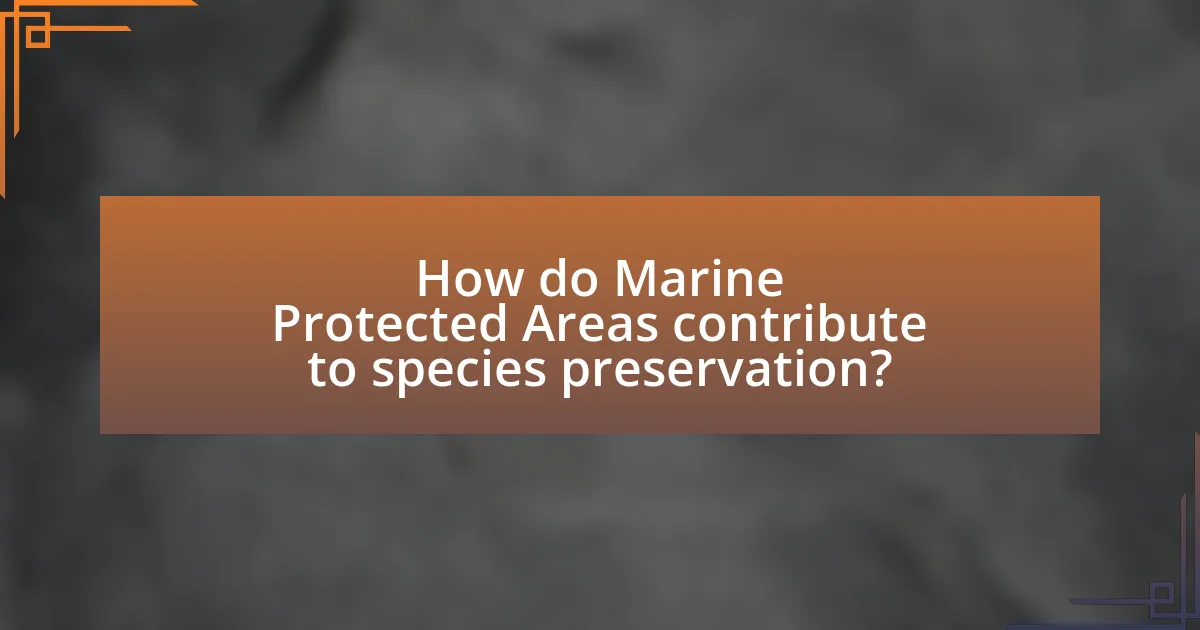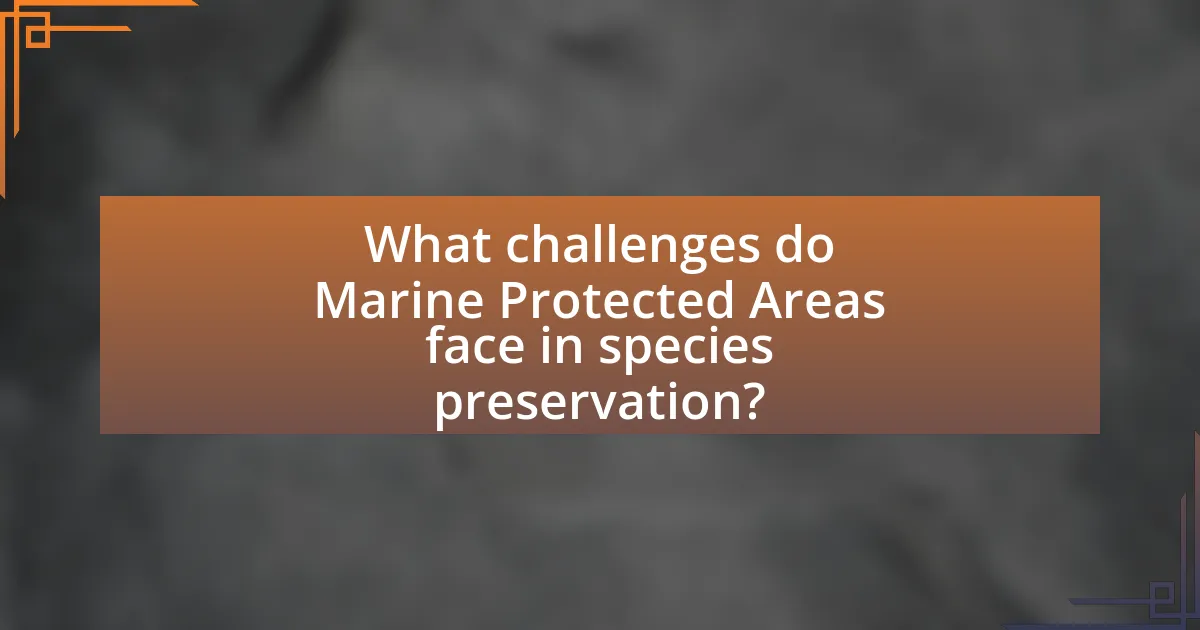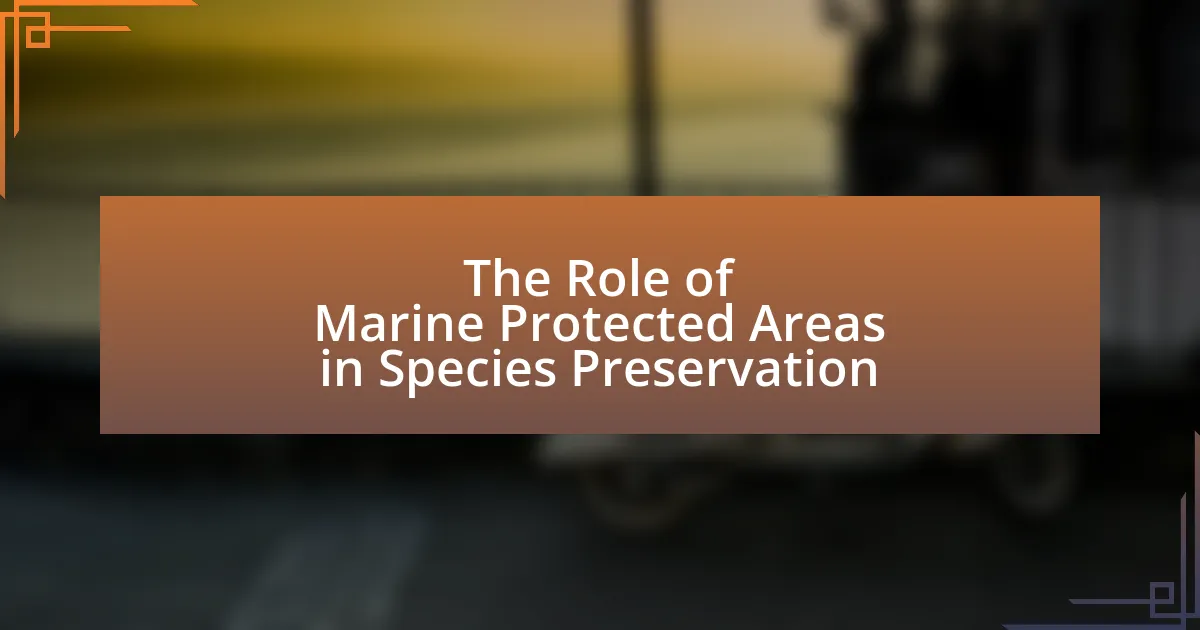Marine Protected Areas (MPAs) are designated regions in oceans and coastal areas where human activities are regulated to conserve marine ecosystems and biodiversity. This article explores the definition, categorization, and types of MPAs, highlighting their importance in preserving marine life and habitats. It discusses the mechanisms MPAs use to protect species, the challenges they face, and the evidence supporting their effectiveness in enhancing fish populations and promoting sustainable fisheries. Additionally, the article emphasizes the role of community involvement and best practices in improving MPA management for better species preservation.
-1.webp)
What are Marine Protected Areas (MPAs)?
Marine Protected Areas (MPAs) are designated regions in oceans and coastal areas where human activities are regulated to protect marine ecosystems and biodiversity. MPAs aim to conserve marine life, habitats, and cultural resources by limiting activities such as fishing, mining, and development. According to the International Union for Conservation of Nature (IUCN), as of 2021, approximately 7.6% of the world’s oceans are covered by MPAs, which play a crucial role in enhancing fish populations and promoting ecosystem resilience.
How are MPAs defined and categorized?
Marine Protected Areas (MPAs) are defined as designated regions in marine environments where human activities are regulated to conserve biodiversity and ecosystems. MPAs are categorized based on their level of protection and management objectives, which can include fully protected areas, where no extractive activities are allowed, and multiple-use areas, where certain activities are permitted under specific regulations. For instance, the International Union for Conservation of Nature (IUCN) classifies MPAs into six categories, ranging from strict nature reserves to sustainable use areas, reflecting varying degrees of human interaction and conservation goals. This classification system helps in the effective management and conservation of marine resources, ensuring the protection of critical habitats and species.
What types of MPAs exist and what are their purposes?
Marine Protected Areas (MPAs) can be categorized into several types, including fully protected marine reserves, multiple-use MPAs, and no-take zones. Fully protected marine reserves aim to conserve biodiversity by prohibiting all extractive activities, thereby allowing ecosystems to recover and thrive. Multiple-use MPAs permit various activities, such as fishing and tourism, but regulate them to balance conservation and human use. No-take zones specifically prohibit the removal of any marine resources, ensuring that habitats and species can flourish without human interference. These classifications serve the overarching purpose of preserving marine biodiversity, protecting habitats, and supporting sustainable fisheries, which are critical for ecological balance and human livelihoods.
How do different categories of MPAs vary in their regulations?
Different categories of Marine Protected Areas (MPAs) vary in their regulations primarily based on the level of protection they offer and the activities they permit. For instance, fully protected MPAs, such as no-take zones, prohibit all extractive activities, including fishing and mining, to conserve biodiversity and restore ecosystems. In contrast, multiple-use MPAs allow for regulated fishing, tourism, and other activities, balancing conservation with human use.
The International Union for Conservation of Nature (IUCN) classifies MPAs into six categories, ranging from strict nature reserves (Category Ia) with the highest level of protection to sustainable use reserves (Category VI) that permit resource extraction under specific regulations. This classification system helps to define the specific rules governing activities within each MPA, ensuring that conservation goals are met while accommodating human interests.
Why are MPAs important for marine ecosystems?
Marine Protected Areas (MPAs) are crucial for marine ecosystems because they provide a refuge for biodiversity, allowing species to thrive without the pressures of human activities such as overfishing and habitat destruction. MPAs help to restore fish populations and enhance ecosystem resilience; for instance, studies show that fish biomass can increase by an average of 600% within fully protected areas. Additionally, MPAs contribute to the preservation of critical habitats, such as coral reefs and mangroves, which are essential for the survival of many marine species. The establishment of MPAs has been linked to improved ecosystem health and increased productivity, demonstrating their vital role in sustaining marine life.
What role do MPAs play in biodiversity conservation?
Marine Protected Areas (MPAs) play a crucial role in biodiversity conservation by providing safe habitats for marine species, allowing ecosystems to recover and thrive. MPAs restrict human activities such as fishing, mining, and tourism, which can lead to habitat degradation and species decline. Research indicates that MPAs can increase fish populations by up to 600% within their boundaries, as demonstrated in a study published in the journal “Nature” by Halpern et al. (2010), which analyzed the effectiveness of MPAs globally. This protection helps maintain ecological balance, supports species diversity, and enhances resilience against climate change impacts.
How do MPAs contribute to the health of marine habitats?
Marine Protected Areas (MPAs) enhance the health of marine habitats by providing a refuge for biodiversity and allowing ecosystems to recover from human impacts. MPAs restrict activities such as overfishing and pollution, which helps to restore fish populations and improve habitat quality. For instance, studies have shown that fish biomass can increase by up to 600% in fully protected areas compared to unprotected regions, demonstrating the effectiveness of MPAs in promoting ecological resilience. Additionally, MPAs support the recovery of critical habitats like coral reefs and seagrasses, which are essential for numerous marine species and overall ecosystem health.

How do Marine Protected Areas contribute to species preservation?
Marine Protected Areas (MPAs) contribute to species preservation by providing safe habitats where marine life can thrive without the pressures of human activities such as fishing and pollution. These designated areas help maintain biodiversity by protecting critical ecosystems, allowing species populations to recover and maintain their natural behaviors. For instance, studies have shown that fish populations in MPAs can increase by up to 600% compared to unprotected areas, demonstrating the effectiveness of these zones in fostering healthy marine environments. Additionally, MPAs can enhance the resilience of marine species to climate change by preserving essential habitats like coral reefs and mangroves, which serve as nurseries for various marine organisms.
What mechanisms do MPAs use to protect species?
Marine Protected Areas (MPAs) use several mechanisms to protect species, including habitat protection, fishing regulations, and biodiversity conservation. Habitat protection involves designating specific areas where human activities are restricted or managed to preserve critical ecosystems, such as coral reefs and mangroves, which are essential for various marine species. Fishing regulations, such as catch limits and seasonal closures, help prevent overfishing and allow fish populations to recover, thereby supporting sustainable ecosystems. Additionally, MPAs often implement monitoring and enforcement measures to ensure compliance with regulations, which further enhances species protection. Studies have shown that MPAs can lead to increased fish biomass and diversity, demonstrating their effectiveness in species preservation.
How do no-take zones within MPAs enhance species recovery?
No-take zones within Marine Protected Areas (MPAs) enhance species recovery by prohibiting all forms of extraction, allowing ecosystems to regenerate and populations to increase. This protection leads to higher biomass and biodiversity, as evidenced by studies showing that fish populations in no-take zones can be up to five times larger than in adjacent areas open to fishing. Furthermore, these zones serve as critical habitats for breeding and spawning, contributing to the overall resilience of marine ecosystems. Research conducted by Halpern et al. (2010) in “Marine Protected Areas and Resilience to Climate Change” highlights that no-take zones significantly improve the recovery rates of overexploited species, demonstrating their effectiveness in conservation efforts.
What is the impact of MPAs on endangered species populations?
Marine Protected Areas (MPAs) significantly enhance the populations of endangered species by providing safe habitats free from overfishing and habitat destruction. Research indicates that MPAs can lead to increased biomass and density of endangered species, as they allow for recovery and reproduction without human interference. For example, a study published in “Conservation Biology” by Edgar et al. (2014) found that fish populations within MPAs were, on average, 2.5 times more abundant than those in unprotected areas. This evidence demonstrates that MPAs play a crucial role in the conservation and recovery of endangered species populations.
What evidence supports the effectiveness of MPAs in species preservation?
Marine Protected Areas (MPAs) effectively support species preservation by providing safe habitats that reduce human impacts. Research indicates that MPAs lead to increased biodiversity and biomass within their boundaries. For instance, a meta-analysis by Edgar et al. (2014) published in “Nature” found that fish populations in MPAs were, on average, 670% larger than those in unprotected areas. Additionally, the study highlighted that MPAs contribute to the recovery of overfished species, with specific examples including the recovery of the Nassau grouper in the Caribbean due to MPA implementation. These findings demonstrate that MPAs play a crucial role in enhancing species populations and biodiversity.
What case studies demonstrate successful species recovery due to MPAs?
Case studies demonstrating successful species recovery due to Marine Protected Areas (MPAs) include the recovery of the Nassau grouper in the Caribbean and the California sea otter along the Pacific coast of the United States. The Nassau grouper, once critically endangered, saw population increases after the establishment of MPAs in the Bahamas, where fishing pressure was significantly reduced, leading to a 300% increase in their numbers over a decade. Similarly, the California sea otter population rebounded from near extinction in the 1970s, with current estimates showing over 3,000 individuals, largely due to protective measures implemented in MPAs that restricted hunting and habitat destruction. These examples illustrate the effectiveness of MPAs in facilitating species recovery through targeted conservation efforts.
How do MPAs influence fish populations and fisheries sustainability?
Marine Protected Areas (MPAs) significantly enhance fish populations and promote fisheries sustainability by providing safe habitats where fish can reproduce and grow without the pressures of fishing. Research indicates that MPAs can lead to increased biomass and diversity of fish species within their boundaries, as evidenced by a study published in “Nature” by Lester et al. (2009), which found that fish populations in MPAs were, on average, 2.5 times larger than those in unprotected areas. This increase in fish populations contributes to the replenishment of surrounding fisheries, as adult fish can migrate outside MPAs to support commercial and recreational fishing. Furthermore, MPAs help maintain ecosystem balance, which is crucial for long-term sustainability, as they protect critical habitats and reduce overfishing impacts.

What challenges do Marine Protected Areas face in species preservation?
Marine Protected Areas (MPAs) face significant challenges in species preservation, primarily due to inadequate enforcement of regulations. Many MPAs lack sufficient resources and personnel to monitor and enforce protection measures effectively, leading to illegal fishing and habitat destruction. For instance, a study published in “Conservation Biology” by Edgar et al. (2014) found that only 30% of MPAs globally are effectively managed, which directly impacts their ability to preserve biodiversity. Additionally, climate change poses a threat to MPAs, as rising ocean temperatures and acidification can alter habitats and species distributions, undermining conservation efforts. These challenges highlight the need for improved management strategies and resources to enhance the effectiveness of MPAs in preserving marine species.
What are the main threats to the effectiveness of MPAs?
The main threats to the effectiveness of Marine Protected Areas (MPAs) include illegal fishing, pollution, climate change, and inadequate enforcement. Illegal fishing undermines conservation efforts by depleting fish stocks within MPAs, as evidenced by studies showing that up to 30% of global fish catches are illegal. Pollution, particularly from plastics and chemicals, degrades marine habitats and affects biodiversity, with reports indicating that over 8 million tons of plastic enter oceans annually. Climate change leads to ocean warming and acidification, which threaten marine ecosystems, as highlighted by the Intergovernmental Panel on Climate Change, which predicts significant impacts on marine life. Inadequate enforcement of regulations within MPAs allows these threats to persist, with many MPAs lacking sufficient resources or personnel to monitor and protect their boundaries effectively.
How does illegal fishing undermine MPA goals?
Illegal fishing undermines Marine Protected Area (MPA) goals by depleting fish populations and disrupting ecosystem balance. MPAs are designed to conserve marine biodiversity and promote sustainable fishing practices; however, illegal fishing activities bypass these regulations, leading to overfishing and habitat destruction. For instance, a study published in the journal “Marine Policy” found that illegal fishing can reduce fish biomass by up to 50% in protected areas, directly contradicting the objectives of MPAs to enhance fish stocks and biodiversity. This illegal activity not only threatens the sustainability of marine resources but also diminishes the effectiveness of conservation efforts aimed at preserving species and their habitats.
What role does climate change play in MPA effectiveness?
Climate change significantly undermines the effectiveness of Marine Protected Areas (MPAs) by altering marine ecosystems and species distributions. As ocean temperatures rise and acidification occurs, the habitats that MPAs aim to protect can become less suitable for the species they harbor. For instance, coral reefs, which are critical to biodiversity, are experiencing bleaching events due to increased water temperatures, leading to declines in fish populations that rely on these habitats. A study published in “Nature Climate Change” by Hoegh-Guldberg et al. (2018) indicates that without addressing climate change, the benefits of MPAs may be severely compromised, as shifting species may migrate outside protected boundaries, reducing the intended conservation outcomes.
How can the management of MPAs be improved for better species preservation?
Improving the management of Marine Protected Areas (MPAs) for better species preservation can be achieved through enhanced stakeholder engagement, adaptive management practices, and robust scientific monitoring. Engaging local communities and stakeholders fosters collaboration and ensures that management strategies reflect the needs and knowledge of those directly affected. Adaptive management allows for the continuous adjustment of strategies based on monitoring data and changing environmental conditions, which is crucial for responding to threats such as climate change. Furthermore, implementing comprehensive scientific monitoring programs provides essential data on species populations and ecosystem health, enabling informed decision-making. Research indicates that MPAs with active management and monitoring show significantly higher biodiversity and species recovery rates, underscoring the importance of these strategies in effective MPA management.
What best practices can enhance MPA management strategies?
Effective Marine Protected Area (MPA) management strategies can be enhanced through stakeholder engagement, adaptive management, and scientific research integration. Stakeholder engagement ensures that local communities, fishers, and conservationists contribute to decision-making, fostering compliance and support; studies show that MPAs with active community involvement have higher success rates in biodiversity conservation. Adaptive management allows for the continuous improvement of strategies based on monitoring and evaluation, which is crucial as environmental conditions change; for instance, the Great Barrier Reef Marine Park employs adaptive management to respond to coral bleaching events. Lastly, integrating scientific research into management practices provides data-driven insights that inform policy and operational decisions, as evidenced by the use of ecological data in the design and zoning of MPAs, which has been shown to enhance ecological outcomes.
How can community involvement strengthen MPA effectiveness?
Community involvement can strengthen Marine Protected Area (MPA) effectiveness by fostering local stewardship and enhancing compliance with regulations. When communities actively participate in the management and decision-making processes of MPAs, they are more likely to support conservation efforts and adhere to guidelines. Research indicates that MPAs with strong community engagement report higher levels of compliance and better ecological outcomes. For instance, a study published in “Conservation Biology” by Charles et al. (2016) found that community-led initiatives in MPAs led to a 30% increase in fish biomass compared to areas without such involvement. This demonstrates that local knowledge and commitment can significantly enhance the management and success of MPAs in preserving marine biodiversity.
What practical steps can individuals take to support Marine Protected Areas?
Individuals can support Marine Protected Areas (MPAs) by participating in local conservation efforts, advocating for policy changes, and practicing sustainable behaviors. Engaging in beach clean-ups and volunteering with organizations focused on marine conservation directly contributes to the health of MPAs. Advocacy for stronger environmental policies can influence government decisions regarding the establishment and enforcement of MPAs. Additionally, adopting sustainable practices, such as reducing plastic use and choosing sustainably sourced seafood, helps minimize human impact on marine ecosystems. Research indicates that community involvement and sustainable practices significantly enhance the effectiveness of MPAs in preserving biodiversity and marine life.
